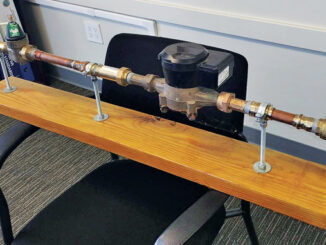Water testing in the town and village was expected to be completed on Thursday. To date, 14 samples have returned from the lab and tested negative for actionable levels of lead and copper.
According to a 1991 law, the Environmental Protection Agency requires the testing of water from any home built between 1982 and 1986. Water Department Superintendent Mike Trainor said homes built during this time had lead used in the solder in the water pipes.
The frequency of testing depends on the results. The town and village had been on reduced monitoring for lead and copper because of favorable results in the past, but changes in the source of water has required two rounds of testing to be completed this year.
“We add a chemical to the water called zincortho-phosphate,” Trainor said. “It’s a corrosion control agent which adheres to the inside of the water pipes and encapsulates the water pipes so any lead or copper won’t leach out into the water. We only add that chemical to our water production at the Catskill filtration plant. When the aqueduct went down, at the end of October, for repairs, we no longer were adding that chemical to our water system. Because we switched the source of water to our well facility full time, that’s what caused the need for us to go back to the regular sampling schedule.”
Notices went out to 60 homeowners at the end of January and test kits were delivered on Feb. 11.
Trainor explained a minimum of 40 residents were required to fill the supplied one-liter bottles with water after at least six hours had elapsed from the last time a particular faucet was used. Samples were then picked up by the Water Department and submitted to a lab in Newburgh.
As of last week, 35 samples had been collected, but Trainor said residents have been cooperative and remained optimistic he would meet the minimum requirement.
Trainor said if more than 10 percent of the samples had tested positive for lead and copper, further action would be required. Another round of testing will be completed late summer/early fall.
“Assuming this year’s sampling passes and there’s no actionable levels of lead and copper in the water, next year we will only have to test the samples once a year and again the following year,” Trainor said. “If samples come back clean over those three years, we’ll go back to reduced monitoring and will only have to submit samples every three years.”
Although Cornwall’s water is tested regularly, Trainor said any positive test of lead and copper would not indicate the elements’ presence in the water system, but rather the individual household.



